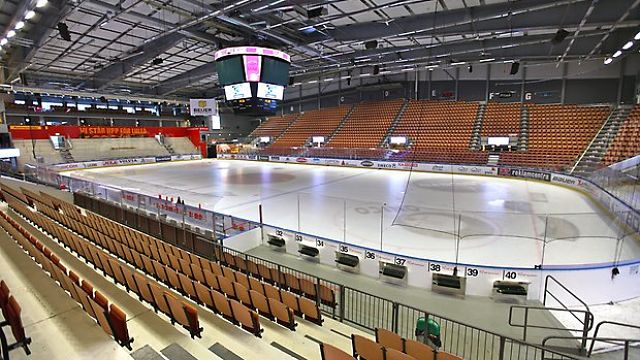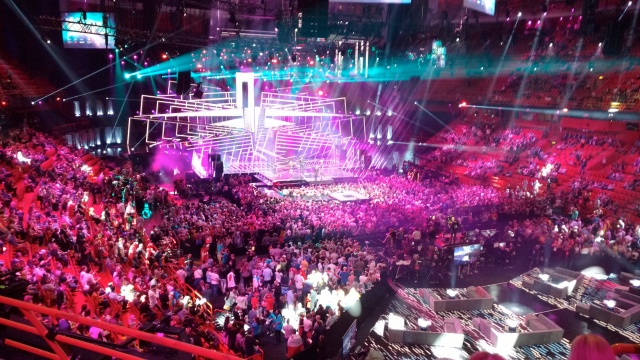It had been nearly two years since I felt it.
I was inside of the Avicii Arena for the second heat of Melodifestivalen. It’s a special place, this host city of two Eurovision Song Contests and an unmissable landmark on the Stockholm skyline. Just entering and taking a seat high up the curved banks gives you a buzz that you aren’t inside of just any arena but one that is architecturally unique and simply perfect for all things Song Contest.
And I wasn’t the only one feeling that. This second heat was the first Melodifestivalen show without crowd limiting restrictions since 2020. Even before the show started there was a special feeling in the space with the crowd clapping along, dancing in the aisles, enjoying being able to have a good time.
But during the competing songs, when the audience matters, I got those Eurovision goosebumps that I’ve missed for years – that buzz that something special was happening as the beat dropped in Liamoo’s ‘Bluffin’’ and the entire crowd was cheering and willing this smash hit to smash through to the final. I’m asked a lot why I travel across the country and internationally to competitions like this each winter. It’s for this reason – this buzz – that has a hold on me and I am addicted to get as much as possible.

Liamoo and John Lundvik celebrate their victory in Melodifestivalen heat 2 (Photo: Annika Berglund, SVT)
And while these were good goosebumps, considering how long it had been I know they could have been so much better.
That’s because I was looking around an arena that has pockets of energy, rather than absolutely popping. This is the first Melodifestivalen since restrictions were released, and a full arena a possibility for the first time since 2020, but I reckon calling Globen a quarter-full would be a massive overestimate. The floor, and one side on the first tier was being used, everything else stood empty. The reason I was even inside the arena tonight is that SVT offered us as press complete freedom to sit here on Globen’s second tier free of charge to observe the madness that is Melfest.
And if you thought that was bad, spare a thought for tonight’s heat 4.
To The National Football Stadium
When SVT decided that it would be “indefensible” to travel around the country this year, restrictions or no restrictions, that meant the show would be staying put in Stockholm for six weeks. And while the Avicii Arena seems like the perfect venue to host Eurovision…that was only a possibility for those first three weeks. The Avicii Arena has been booked for this weekend for a concert by Tomas Ledin, the country’s Eurovision act in 1980, and despite what the media have reported on being some heated conversations he is still performing inside the world’s largest hemispherical building this weekend.
So SVT had to move to another Stockholm location. Thankfully the opposite end of town had the perfect solution. Friends Arena, the national football stadium already scheduled to host the Final of Melodifestivalen. It often lies empty in these winter months while the football season is on hiatus, and it is the logical choice to host Melodifestivalen for the final three weeks of the tour.
The problem is that Friends Arena is the biggest indoor venue in the country, where normally a capacity for 30,000 people attend the final of Melodifestivalen each year, and that only uses half the stadium. If the Avicii Arena was struggling to be anywhere close to being full, how will the show feel in this behemoth of a venue?
Firstly, the show has been designed to be in a much smaller space. None of the tiered stands of the stadium are being used, and instead the only seating is available on the floor, or via a temporary stand that has been brought into the venue. The capacity of this is a fraction of the 30,000 that would normally be present. While there are still tickets available for tonight’s show, the majority of seats available have been taken and the feel should be similar to that of the bandy arena in Lidköping that was meant to host this fourth heat.̈

The long curtain sectioning off the middle of Friends Arena from the seats outside (Photo: Ben Robertson, ESC Insight)
To complement the look and feel inside doesn’t feel like Friends Arena at all. A two storey tall black curtain is held by rigging around the arena, helping to create extra intimacy. There are also spotlights at the top of this curtain pointing downwards towards the audience which helps to minimise the fact that the 240 square metre roof covering the stadium is many times higher.
There are also camera shot changes as well, with none of the iconic long shots that have been used to transmit the huge size and scale of Friends Arena to the TV audience. There is a spider cam in operation for tonight’s show, but held at a much lower height than usual and sweeping far closer to the stage.
The end result is that the average viewer would not even notice. However Melodifestivalen knows itself too well and Oscar Zia’s interval act includes scripted jokes about moving about 30 minutes on the commuter rail network to the other side of Stockholm, complete with a blink-and-you-miss-it reference to the year’s poor ticket sales.

Oscar Zia performing during the interval act of heat 4 of Melodifestivalen (Photo: Annika Berglund, SVT)
Why Supply Exceeds Demand
Usually, tickets for the Melodifestivalen heats are hot property and easily sell out as the show tour’s the nation. The normal routine is that the Friday night rehearsal, Saturday matinée and live show are packed with thousands each week no matter where in the nation the show lands. Here in Stockholm tickets for the heat 1 Friday rehearsal struggled to attract more than a couple of hundred attendees, even when government restrictions limited attendance to that first heat, and the selling of rehearsal tickets was quietly dropped for future weeks.
There’s multiple reasons why the numbers of tickets being sold this year are significantly less. One obvious, unignorable truth is that, restrictions or no restrictions, the pandemic is not behind us either way, and that will have an impact in many people’s decision making.
Furthermore we have to remember that when the show visits small towns around the country, it provides an opportunity for families in the local area to attend one of the biggest events on the town’s calendar. Especially in towns like Luleå which hosted a heat in 2020, for many families it is a once-in-a-generation event to have the country’s biggest extravaganza on your doorstep, rather than taking travelling for hours if not days for the experience. That isn’t the case for Stockholm, where a Melodifestivalen heat is one of just many entertainment options available to people.

The Coop Norrbotten Arena, host venue for Luleå’s heat of Melodifestivalen 2020 (Photo: Luleå Kommun)
We have to talk about the cost as well. The cost of the cheapest tickets for these Melodifestivalen heats is 600 SEK (£50). This is a normal piece for a ticket to the show as it tours the country – but the difference is the particular privileges of the Stockholm fanbase. In a normal year, with a full Friends Arena will have a larger price differential, with tickets available for the six week climax available cheaper than this heat. If you are only able to afford to go to one show – it is an easy choice in this sitation to go to the final.
It’s important to say at this point that ticket sales are not an SVT responsibility. It is the company Live Nation, the largest organisation in Sweden for events and concerts, that holds the contract to run the Melodifestivalen tour. Without them taking the economic risk the tour would not happen and Melodifestivalen would be a TV show and TV show only, much like last year’s show held with no audience.
The Uncertainty of This New Era
The expectation is that this is of course a one year blip. The Melodifestivalen tour is set to take place as big as ever last year, with the cities and towns that were set to host this last year set to host in 2023.
And there’s no reason to think that Melodifestivalen will struggle to fill those arenas long term. It is still a hit machine, setting a record for heat 2 where all of the songs eligible for release on Spotify (the two pre qualifiers must wait until after heat 4 to be commercially released) hit the top 50 of their chart for the first time. This was repeated the following week, where Melodifestivalen received an audience share of over 75 % and an all time high rating on the broadcaster’s streaming service SVT Play, where the show was started over 1,000,000 times.
Yet there is something eerie about sitting in venues that are a fraction of the capacity, the noise and the atmosphere that they should be. It’s an issue that Stockholm has dealt with before – back in 2016 tickets to afternoon rehearsals for the Eurovision Song Contest were offered to local schools following poor ticket sales. While a Melodifestivalen heat may have much less cultural significance than the Song Contest, one wonders if there is outreach possible here in these rare times seats are so available to spread the love of Melodifestivalen further. It’s not us press that need to have those free seats after all.

Globen, now the Avicii Arena, on Semi Final 2 night (image: Ellie Chalkley)
While there’s only one show with the public this week, and for next week’s Semi Final, the current plan is that the Final in a fortnight’s time will have an audience for all three shows on the Friday and Saturday – and to be on the scale that the show normally is with a full Friends Arena audience. That’s looking promising with the majority of tickets already sold and the seats on the floor of Friends Arena fully taken for the live show.
This slow growth means that the other events around Melodifestivalen can also start to open up. Saturday night’s show will be the first to have an official mingle celebration take place after the show. Looking further forward, Melodifestivalklubben, the Swedish branch of OGAE Sweden, will be organising their Melfest WKND again for the Friday and Saturday night in Stockholm with both Melodifestivalen and Eurovision acts promised to attend. The Melfest bubble doesn’t quite feel right yet, but maybe in two weeks it will do.
Predicting supply and demand in these uncertain times is a challenge for all. It is no surprise with the ever-changing situation about events that there is no news on tickets for the Eurovision Song Contest at this time, nor that on the ground press numbers in Turin will be limited similarly to Rotterdam. What the situation in Stockholm shows is that, even in one of Eurovision’s biggest markets, as we hopefully exit the grips of the pandemic predicting and adapting for demand will be a challenge anywhere.
You can buy tickets for the Melodifestivalen shows at Friends Arena here.
You can also find out more about Melfest WKND here.̈
Thanks to Daniel Stridh from Melodifestivalklubben for the featured image









